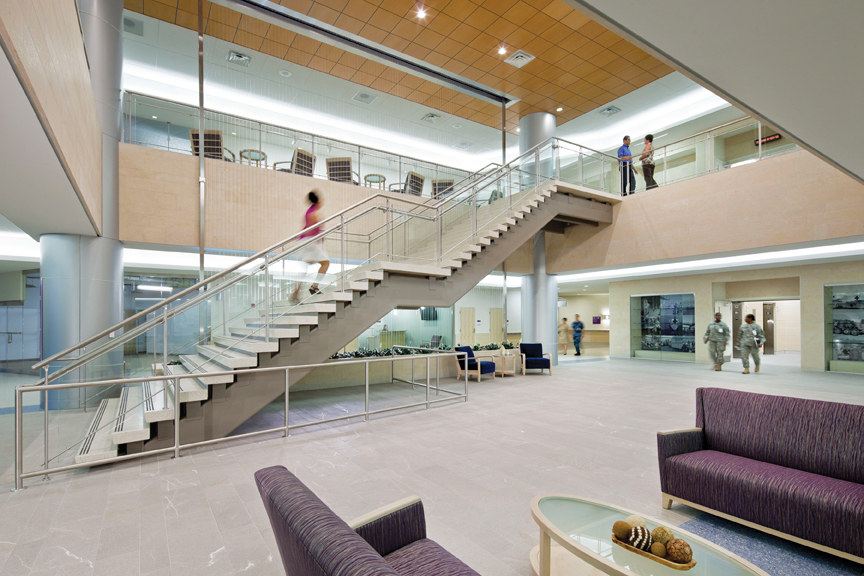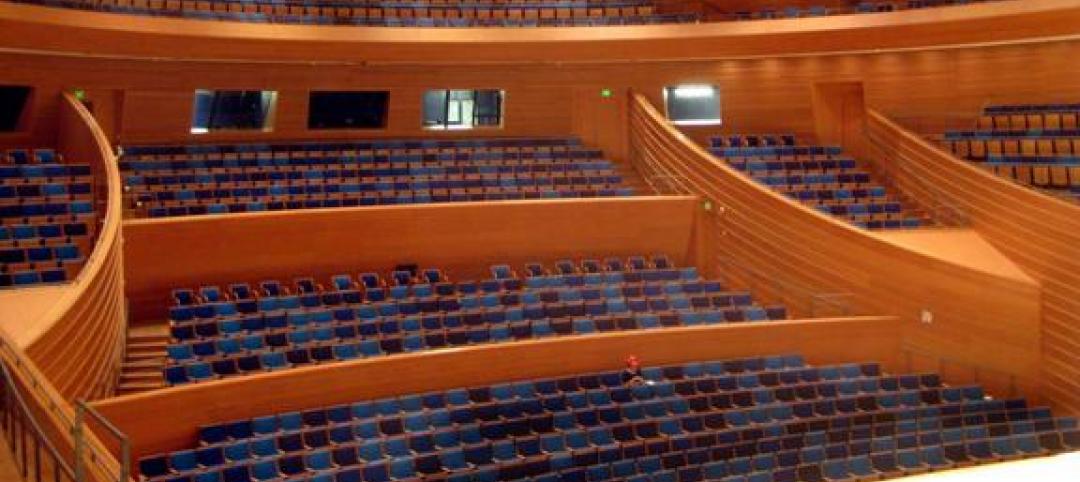2012 Buiding Team Award
Silver Award
Shortly after the passage of the 2005 Base Realignment and Closure Act, the U.S. Army Corps of Engineers initiated a radical reorganization of the military healthcare system in the Washington metropolitan area. The renowned Walter Reed Army Medical Center in the District of Columbia and the DeWitt Army Hospital at Fort Belvoir, Va., were to be closed, while Bethesda Naval Hospital in Maryland would receive massive renovations and a new hospital at Fort Belvoir would be built to support the hundreds of thousands of U.S. active-duty service members, veterans, and military families in the region.
The BRAC law required that the new Fort Belvoir Community Hospital (FBCH) be ready to admit patients on September 15, 2011, a strict deadline that had the Corps scrambling to assemble a Building Team that could deliver a high-quality, billion-dollar project on time. The project was so big and the schedule so tight that it required the work of two joint ventures—HDR and Dewberry (architect/engineer) and Turner Construction and Gilbane Building Co. (construction manager)—to handle it. HDR provided full design and engineering services for the four clinic buildings and main hospital, while Dewberry was responsible for site work and landscaping, as well as full design of an on-site dedicated central utility plant.
To meet the deadline, the USACE imposed a new delivery model, “integrated design-bid-build,” on the Building Team—a first for the Corps. Similar to the early contractor involvement method, IDBB allowed construction to begin while design was still in development; in fact, Turner/Gilbane came on board when overall design was only about 10% complete. Enlisting a contractor early was important to the government, according to HDR vice president Terence Williams, PE, LEED AP. “The idea was to have the contractor working with the design team early on to create a more seamless delivery of the project,” he says.
Turner/Gilbane established a detailed quality control program to ensure that the use of the IDBB delivery method would not detract from the ultimate goal of achieving world-class results. The QC support staff worked with other members of the Building Team independently from Turner/Gilbane’s construction operations crew to ensure high-quality results of complex construction details and features.
Project Summary
SILVER AWARD
Fort Belvoir Community Hospital
Fort Belvoir, Va.Building Team
Submitting entity: Gilbane Building Co.
Owner: U.S. Army Corps of Engineers, Norfolk District
Architect/engineer: HDR/Dewberry (joint venture)
Construction manager: Turner/Gilbane (joint venture)General Information
Project size: 1.27 million gsf (excluding garages)
Construction cost: $1 billion
Construction time: October 2007 to August 2011
Delivery method: Integrated design-bid-build
During the design development phase, the mass of the total structure was increased, which made it impossible to use spread footings for the foundation. After evaluating alternatives, the JV teams opted to use controlled modulus columns (CMC), or grouted columns formed using an auger that displaces soils laterally, thereby avoiding spoils. During auger extraction, a column of concrete is formed through pressure grouting; this resulted in a solid foundation that would withstand the region’s questionable soil conditions.
BIM was also used to visualize and streamline the above-ceiling placement of MEP equipment. With design and construction happening concurrently, BIM preplanning among Building Team members was instrumental in moving the delivery process along. MEP coordination for the various facilities in the project was completed one floor at a time, and models showed where placements needed adjusting to fit the design that was emerging from the BIM model. These adjustments allowed for more precise material orders as well as fewer change orders, thus helping to keep project costs in line.
FBCH is the first major military healthcare facility to incorporate extensive evidence-based design. All hospital features, from landscaping to lighting, were designed to improve patient outcomes by following five core EBD principles:
1. Create a patient- and family-centered hospital environment.
2. Improve the quality and safety of healthcare.
3. Provide patients with contacts to nature and positive distractions.
4. Create a positive work environment for staff.
5. Design for future growth while maximizing standardization.
To optimize indoor air quality, UV technology was installed inside air handlers to help keep coils clean, preventing harmful microorganisms and pathogens from growing inside HVAC systems. CO2 monitors were installed, along with HEPA filtration technology, which traps 99.97% of particles greater than 0.3 microns. This was especially important in several critical locations in the hospital to reduce the risk of infection for immunocompromised patients.
Sustainability features included “swooped” roofs on clinic buildings to direct rainwater to two underground cisterns capable of storing a combined total of 160,000 gallons for landscape irrigation; energy-efficient HVAC and lighting systems that are projected to consume 27% less energy than typical hospitals; and green roof systems and rain gardens to provide calming views of nature and absorb stormwater runoff. The project achieved LEED-NC Silver certification, but LEED Gold is anticipated when final reviews are completed.
Completed within four years, the nearly $1 billion, 1.27-million-sf FBCH is a seven-level hospital set on 75 acres. The complex contains 120 inpatient beds, a 10-bed intensive care unit, a 10-bed behavioral health unit, a cancer center, an emergency department, a pharmacy, 10 operating rooms, diagnostic centers, and modular clinic space for outpatient services, plus two parking garages, a helipad, and an ambulance shelter.
Since opening in August 2011, Fort Belvoir Community Hospital has cared for numerous wounded service personnel returning from Iraq and Afghanistan. Philip Federle, a retired USACE senior program manager, says the facility has been inspected by senior medical leaders, both military and civilian. “All have rated it extremely high in terms of quality and state-of-the-art capability,” says Federle. “It is truly a world-class hospital.” BD+C
--
Click here to view exclusive video interviews of the 2012 Building Team Awards judges explaining their selections.
Related Stories
| Apr 24, 2012
AECOM design and engineering team realizes NASA vision for Sustainability Base
LEED Platinum facility opens at NASA Ames Research Center at California’s Moffett Field.
| Apr 13, 2012
Goettsch Partners designs new music building for Northwestern
The showcase facility is the recital hall, an intimate, two-level space with undulating walls of wood that provide optimal acoustics and lead to the stage, as well as a 50-foot-high wall of cable-supported, double-skin glass
| Apr 4, 2012
Educational facilities see long-term benefits of fiber cement cladding
Illumination panels made for a trouble-free, quick installation at a cost-effective price.
| Jan 26, 2012
Hendrick Construction completes Osso Restaurant in Charlotte
Designed by François Fossard, Osso's upscale interior includes tapered, twisted decorative columns and an elegant fireplace in the center of the lounge.
| Nov 28, 2011
Armstrong acquires Simplex Ceilings
Simplex will become part of the Armstrong Building Products division.
| Sep 14, 2011
Insulated metal wall panels adorn Pennsylvania hospital
The $40 million, 80,000 sf medical office building includes more than 7,000 sf of architectural flat insulated metal wall panels.
| Sep 9, 2011
Kauffman Center for the Performing Arts in Kansas City opens this month
Theatre Projects played the lead role in theatre design and planning as well as in engineering the customized theatre equipment. BNIM in Kansas City served as the executive architect.
| Aug 23, 2011
Acoustical design education model
Pass this exam and earn 1.0 AIA/CES Discovery learning units. You must go to www.BDCnetwork.com/EnhancedAcousticalDesign to take this exam.
| Aug 19, 2011
Enhanced acoustical design
Ambient noise levels in some facility types are trending up and becoming a barrier to clear communication between building occupants.














